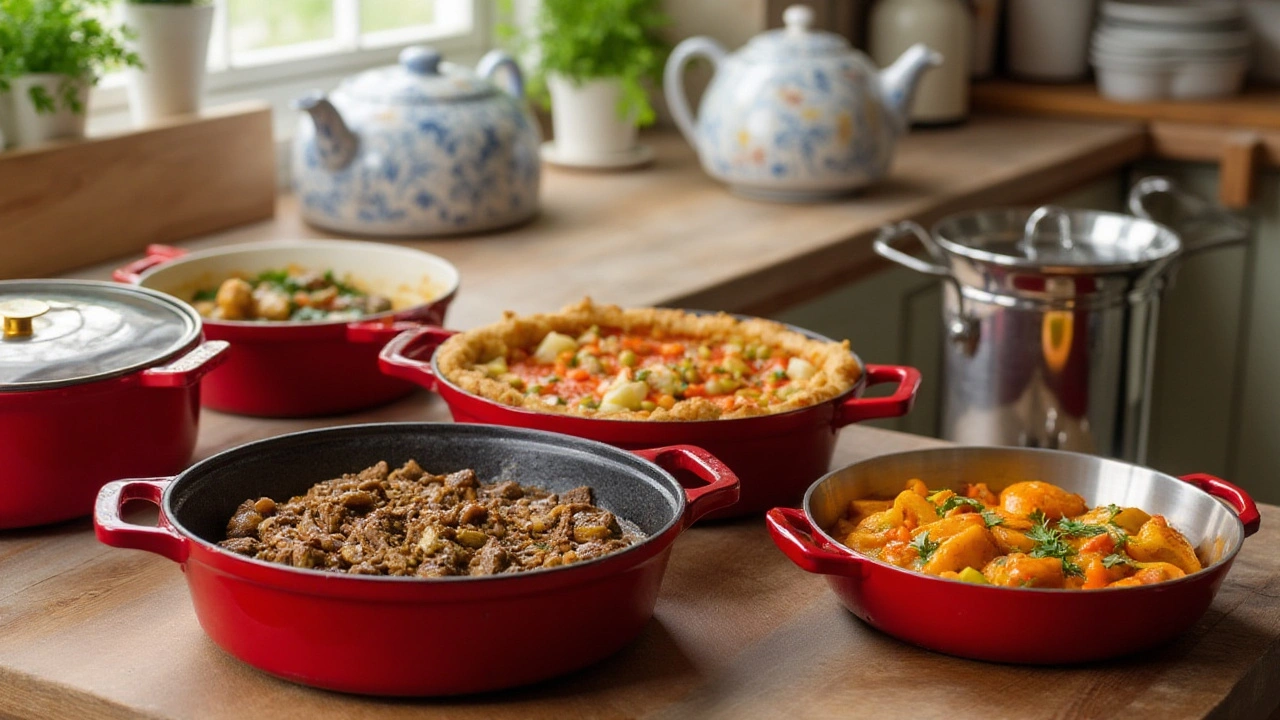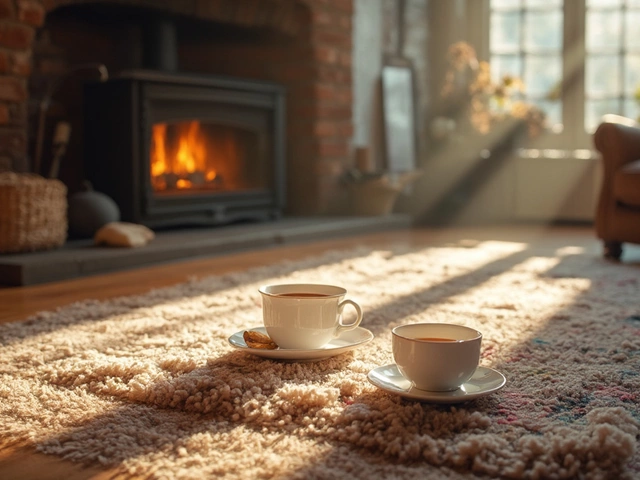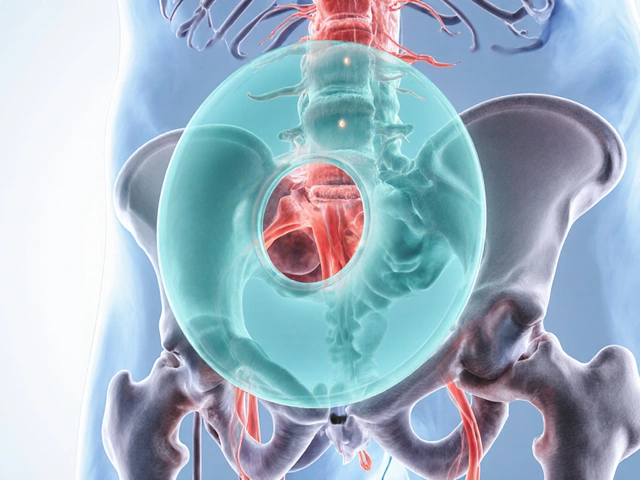Deep pans are a staple in many kitchens around the world. They come with high sides and are incredibly useful for a variety of cooking methods. Unlike shallower pans, their depth accommodates liquid-heavy recipes beautifully, making them perfect for stews, sauces, and more.
Their design isn't just about size; it's about functionality. Deep pans often come with lids, helping retain moisture and flavor during those lengthy cooking endeavors. They hold heat well and distribute it evenly, which is crucial for dishes that require gentle simmering or slow cooking.
Whether you're a novice cook or an experienced chef, understanding the different types of deep pans and how they can enhance your cooking can be immensely beneficial. From materials to proportions, each aspect of selecting a deep pan can influence the outcome of your culinary creations significantly.
- What is a Deep Pan?
- Common Types of Deep Pans
- Materials and Their Benefits
- Choosing the Right Deep Pan
- Cooking Techniques with Deep Pans
- Care and Maintenance Tips
What is a Deep Pan?
The deep pan, a cornerstone of culinary versatility, is a marvel of kitchenware that goes beyond the capabilities of its shallow counterparts. These pans, sometimes nestled under the broad category of casserole dishes or braisers in retail, boast higher sides which open up a world of cooking possibilities. Traditionally circular, but often available in oval or rectangular shapes, deep pans are designed to provide ample room for ingredients that need to move around without spilling. The height of the sides is particularly advantageous for complex dishes which require layering or a slow reduction of sauces.
Famed for their ability to retain and evenly distribute heat, deep pans are ideal for methods such as roasting, deep-frying, or preparing hearty one-pot meals. Imagine the rich, slow-cooked flavors that emerge from dishes like coq au vin or beef bourguignon; these delicacies rely on the precise heat management and moisture control that a deep pan offers. According to Sara Jenkins, a celebrated chef specializing in rustic Italian cuisine, "The secret to a great stew or braise is the cookware. A quality deep pan serves as much a role as the ingredients themselves."
"A deep pan isn't just a tool; it’s almost like an assistant that ensures the desired consistency of your dish while preserving the essence of the flavors," says Jenkins.
The material of a deep pan can greatly influence its effectiveness. Options range from cast iron, known for its incredible heat retention, to stainless steel, which offers durability and is often favored for its non-reactive properties with acidic ingredients. On the other hand, non-stick versions provide ease of cleaning and are handy for dairy-heavy or sticky preparations. The weight of the pan is an important consideration; heavier pans tend to offer superior heat distribution, which is crucial when attempting to sear meat evenly before adding liquids for stewing or braising.
Many deep pans come equipped with lids, a feature that should not be overlooked. Lids help in trapping heat and moisture, effectively reducing the cooking time for many meals. This is particularly critical for reducing broths and sauces to their most flavorful states. Thanks to the pan's depth, elements like potatoes, carrots, or larger meat cuts can cook thoroughly in the lower reaches of the pan, while ingredients resting atop benefit from the aromatic steam rising from below.
Let's not forget the role of a deep pan in baking. Though not its primary claim to fame, the pan's high sides make it a fantastic choice for certain baked goods or casseroles that may hatch surprises if they boil over in a more conventional baking dish. From lasagnas to sumptuous cobblers, the assurance of deep sides provides enough space for the rise and expansion required in baking, ensuring a tidy and spill-free process.
The true charm of the deep pan lies in its ability to adapt across cultures and cuisines. Whether it's a Moroccan tagine, a classic French poulet rôti, or even a simple, heartwarming pot of homemade chili, having the right deep pan ensures that each recipe is simmered or roasted to culinary perfection. For those piecing together a functional kitchen, investing in a quality deep pan is not just a choice, but a delightful gateway to exploring myriad flavors and cooking styles from around the globe.
Common Types of Deep Pans
Deep pans, cherished for their versatility in the kitchen, come in a variety of shapes and sizes, each designed to cater to different cooking needs. While the basic concept of a deep pan remains constant, its subtle variations make them suitable for specific culinary tasks. Let’s delve into some commonly found types that are staples in many households.
1. Casserole Dish
Casserole dishes are perhaps the most familiar to home cooks, characterized by their deep construction and lid, perfect for slow-cooking and baking. Known for their ability to move seamlessly from stovetop to oven, they are perfect for preparing flavorful stews and casseroles. Most casserole dishes are made from materials like ceramic or enameled cast iron, known for excellent heat retention, allowing your dishes to be cooked evenly. According to cookware enthusiasts, a solid casserole dish can last a lifetime, evolving like fine wine with every use as it develops a seasoned coating that enhances the flavors of your meals.2. Dutch Ovens
Dutch ovens hold a special place in the hearts of cooks, renowned for their durability and heat-holding capabilities. Typically made from heavy cast iron and coated with enamel, they are ideal for everything from baking bread to braising meats to simmering soups. A Dutch oven's heavy lid plays a critical role in moisture retention, making your dishes not only succulent but also rich in flavor. These deep pans can be a bit hefty on the wallet, but their multi-purpose nature and enduring construction justify the investment, becoming family heirlooms passed down through generations.3. Stock Pots
Stock pots are larger and known for being a kitchen workhorse. With their towering sides, these deep pans are made to handle large volumes, perfect for making stocks, broths, or even boiling pasta and seafood. Typically constructed from stainless steel or aluminum, they offer efficient heat distribution. A traditional stock pot might not have the same old-world charm as a Dutch oven or a casserole dish, but its simplicity and utility have kept it a constant presence in the culinary world.4. Braziers
Providing a less common but equally valuable option is the brazier. Known for slightly wider bases and lower walls, braziers allow for cooking larger pieces of meat or veggies while still being deep enough to manage generous amounts of liquids. They often come equipped with tight-fitting lids to prevent moisture loss. Chefs adore braziers for their grilling capabilities, offering a wonderful sear and transferring seamlessly to the oven for slow roasts. A quote from esteemed chef Jonathan Waxman encapsulates their use perfectly:"A trusty brazier is to meat what a violin is to a musician, crucial and irreplaceable."
Choosing the right deep pan hinges on understanding its intended use and how it aligns with one's cooking habits. Each type complements a different cooking style, and having a selection at your disposal allows you to tackle any recipe with ease. So, next time you're in the market for cookware, consider not just the shape but also the legacy each piece is capable of creating in your kitchen.
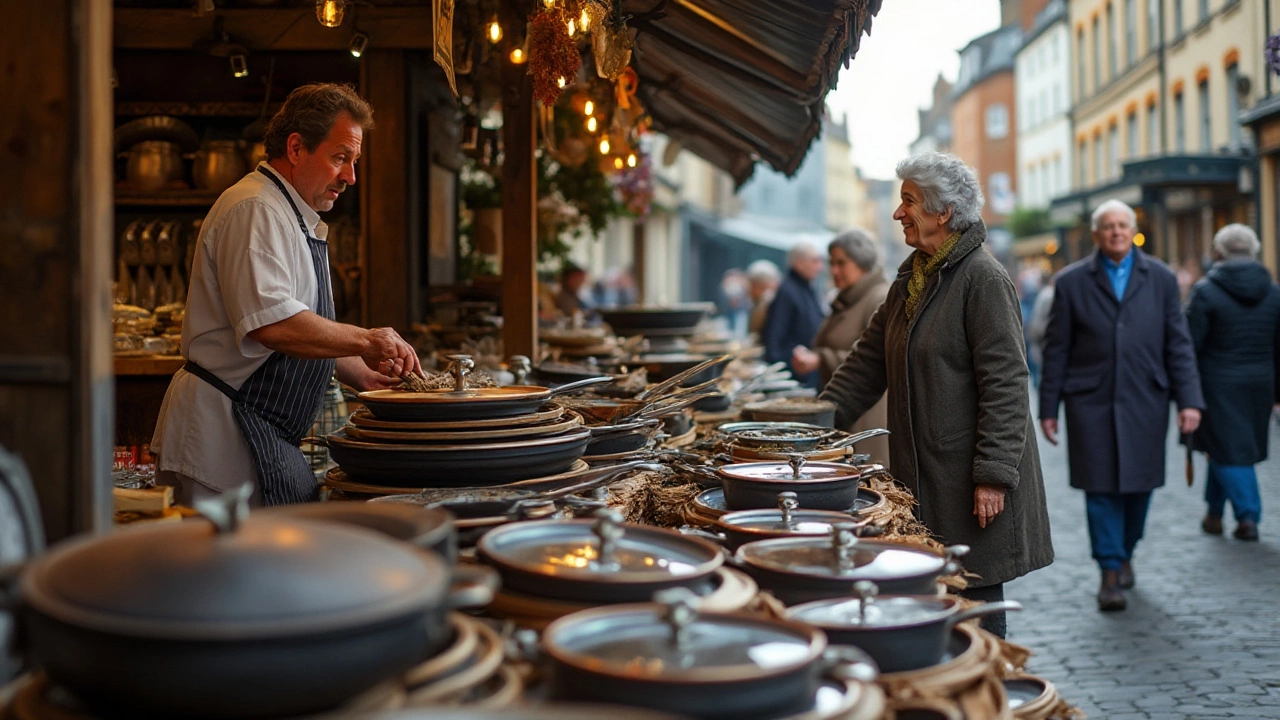
Materials and Their Benefits
When it comes to choosing the right deep pan for your kitchen, the material is a key factor that can influence cooking outcomes significantly. Each material offers its unique perks, affecting everything from heat distribution to ease of cleaning. One of the most common materials is stainless steel, beloved for its durability and resistance to rust and staining. These pans usually incorporate an aluminum or copper core to improve heat conductivity, a vital feature for even cooking. Stainless steel pans are perfect for browning meats and creating rich sauces because of their ability to sustain high temperatures.
Cast iron pans are another popular choice, celebrated for their unparalleled heat retention. Although they can be quite heavy, their weight contributes to remarkable heat distribution, which is ideal for slow cooking and braising. Cast iron pans often come pre-seasoned, forming a natural non-stick layer that enhances cooking. As with anything, they require maintenance; cleaning involves more than just a quick rinse, often needing to be re-seasoned periodically to maintain their effectiveness. Yet, they last generations, which makes them a worthy investment for many home cooks who value both tradition and performance.
One cannot overlook non-stick pans, which have surged in popularity due to their convenience and ease of use. They’re perfect for delicate tasks like simmering tomato sauces or making eggs without sticking. However, it's essential to consider the quality of the non-stick coating as some can degrade at high temperatures over time. Opt for reputable brands that offer PFOA-free coatings, which ensure safety and durability. Non-stick pans typically do not require much oil, making them a healthier choice for those watching their fat intake.
"The type of cookware you choose directly affects your cooking efficiency and the quality of meals," says a culinary expert from the Culinary Institute of America.
In more specialized scenarios, you might find copper pans, which are favored by professional chefs for their superior thermal conductivity. Copper heats up quickly and adjusts instantly to changes in temperature, providing precise control which is crucial in culinary arts. However, copper pans often require linings of stainless steel to prevent reactions with acidic foods, and they demand regular polishing to maintain their appearance. Though they come with a higher price tag, their capabilities in a kitchen-oriented environment can justify the cost for culinary purists seeking excellence in every dish.
If environmental impact is a consideration, there are eco-friendly options like ceramics, which boast non-reactive and non-toxic properties. They provide satisfactory results for low to medium-heat cooking and are apt for baking; albeit, their lifespan isn't as robust as metals or cast irons. Yet, their versatility extends from stovetop to oven, offering a delightful cooking experience while being kind to the planet. Emergence of technology and innovation in cookware has ushered options that cater to every specific need and style, giving cooks a plethora of choices to experiment with.
The table below summarizes some key attributes of these materials:
| Material | Heat Conductivity | Durability | Maintenance |
|---|---|---|---|
| Stainless Steel | Moderate, usually enhanced with core | High | Low |
| Cast Iron | High | Very High | Moderate, requires seasoning |
| Non-Stick | Varies | Moderate | Low, but keep coating intact |
| Copper | Very High | Moderate | High, requires polishing |
| Ceramic | Moderate | Low to Moderate | Low, avoid thermal shock |
Choosing the Right Deep Pan
When it comes to selecting the perfect deep pan for your kitchen, several key factors come into play, and understanding these can greatly influence your cooking experience. First, consider the material. Deep pans come in a variety of materials, each offering distinct advantages. Cast iron deep pans, for instance, are renowned for their heat retention capabilities, making them ideal for slow-cooked meals. On the other hand, stainless steel pans provide quick heating and unparalleled durability, though they may require a learning curve given their conductivity properties.
Another crucial aspect to consider is the size of your deep pan. Sizes vary greatly, and choosing the right one depends on your cooking habits and the number of people you're serving. For family meals and larger gatherings, a deep pan with a higher capacity is advantageous. However, if you're cooking for one or two people, a smaller pan not only suffices but may perform better in terms of heat distribution and cooking time.
Features such as non-stick coatings can be a key deciding factor for many home cooks. While beneficial for frying and sautéing, these coatings can wear out over time if not properly maintained. It’s essential to balance your desire for non-stick convenience with the longevity of your cookware. Moreover, check if the deep pan is oven-safe, as this can vastly expand its uses from stovetop to oven cooking, allowing you to sear and bake with ease in one dish.
Ergonomics also play a pivotal role in selecting the right deep pan. Look for pans with comfortable handles that remain cool to the touch, ensuring safe maneuvering even when the pan is heated. The weight of the pan should also be considered; after all, cookware that's too heavy can make handling cumbersome, negatively impacting your culinary adventure.
According to culinary expert Rebecca Warner, "The choice of your cooking pan affects your culinary output significantly. A carefully selected deep pan can transform your meals from good to exceptional."
Price point is a practical factor that shouldn't be overlooked. While high-end deep pans can promise longevity and superior cooking results, many mid-range options offer an excellent balance of quality and cost-effectiveness. It’s all about aligning your budget with your specific cooking needs without compromising on the necessary features.
A deeper understanding of your own cooking style will help guide you to the best choice. If you frequently prepare dishes that require braising, like short ribs or coq au vin, a cast-iron deep pan could be your best friend. But if you lean towards quicker stir-fries or pasta dishes, perhaps a stainless steel or copper variety might suit you better. Ultimately, the right deep pan should complement not just your kitchen but your lifestyle, enhancing both day-to-day cooking and special culinary occasions.
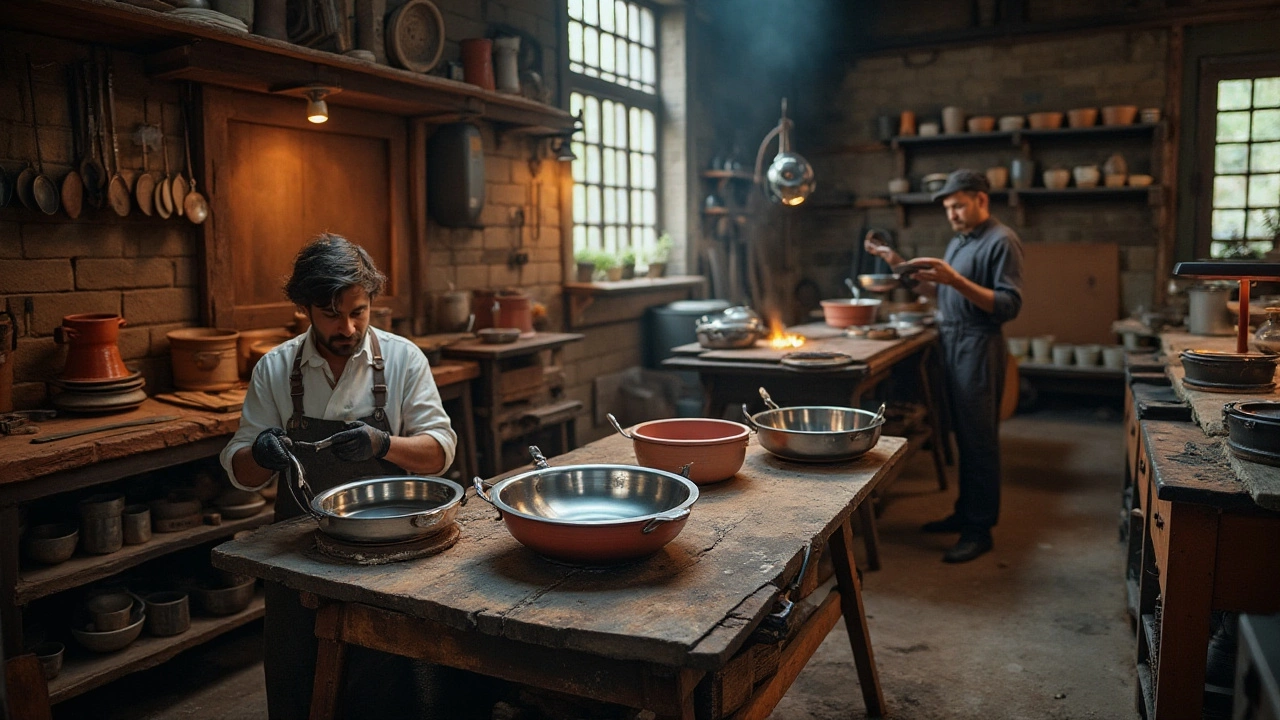
Cooking Techniques with Deep Pans
Deep pans offer a variety of cooking techniques that can transform your culinary repertoire. One of their main attributes is their ability to handle both dry and wet ingredients efficiently, making them perfect for dishes that require a good amount of liquid, such as soups, stews, and broths. Their high sides prevent spillage and help keep the heat focused within the pan, which is crucial for recipes needing extended cooking times. Slow cooking in a deep pan allows flavors to mesh and develop, producing rich and hearty meals. This technique can transform even the simplest ingredients into complex, flavorful dishes. You might find that by letting a stew simmer in this type of cookware, every bite carries a blend of deep notes not achievable through other cooking methods.
Another popular technique with deep pans is braising. This involves searing the food at high temperatures before cooking it slowly in a small amount of liquid. The result? Tender, juicy meats and vegetables that fall apart with the mere touch of a fork. Used by chefs globally, this method enhances the dish's flavor while preserving its delicious moisture. You can elevate your braising game by experimenting with different combinations of broth, wine, herbs, and aromatics. Renowned chefs often refer to braising as an art in itself, as even the quality of the liquid used can make a profound difference in taste.
Incorporating steaming in a deep pan is also highly effective. Although not frequently discussed, the technique involves adding a rack within the pan, above simmering water, to cook food through steam. This method is excellent for preserving nutrients and flavors, particularly in vegetables and fish. Moreover, steaming is a healthy way to cook since it doesn’t require additional fat or oil, allowing the natural flavors to shine. With a simple setup, you can turn your deep pan into an ad-hoc steamer, providing you with even more versatility.
When it comes to sautéing, using a deep pan provides extra space to toss ingredients effortlessly without the fear of spilling over. This technique is ideal for cooking vegetables quickly, ensuring they retain their color, texture, and nutrients. Though traditionally done in shallower pans, sautéing in a deeper one allows for occasional deglazing, adding another dimension of flavor to your meal. While the steam cooks the veggies quickly without wilting them excessively, deglazing with wine or stock can turn what's left on the pan into a savory sauce, tying the dish together seamlessly.
"A deep pan is like a blank canvas for a chef, its depth inspiring creativity and boldness in every dish," notes culinary expert Julia Child, expressing her reverence for this versatile cookware in her acclaimed book "Mastering the Art of French Cooking."
Within these cooking techniques, using a deep pan can open new culinary horizons. Choose ingredients wisely, keep an eye on heat levels, and don't be afraid to experiment. Such cookery offers a bridge to both classic and contemporary cuisines, providing endless ways to create. The beauty of cooking in deep pans lies not only in technique but in the shared moments of indulgence and joy that follow each dish served from it. It's about cultivating skills that become renowned traditions at our tables as much as understanding the science of achieving impeccable textures and flavors.
Care and Maintenance Tips
Taking good care of your deep pan ensures that it remains a reliable tool in your kitchen arsenal for years to come. Proper care starts with knowing the material of your pan. Whether it's cast iron, stainless steel, or non-stick, each material has its quirks and demands specific cleaning methods. For instance, cast iron pans require seasoning to prevent rust and maintain their non-stick surface. A light coat of vegetable oil after washing can work wonders. Stainless steel pans, on the other hand, resist rust but can suffer from stains that require gentle scrubbing with a minimal amount of abrasive cleaner. Non-stick pans, while convenient, are prone to damage from metal utensils and should only be hand-washed with a soft sponge.
Washing your deep pan is crucial but doing so correctly makes all the difference. Never immerse a hot pan directly into water; the rapid temperature change can lead to warping, especially in lower-quality variants. Instead, let it cool on the stove or a heat-proof surface before washing. Make it a habit to use mild dish soap with warm water, which is generally sufficient for most cleaning tasks. If food sticks, fill the pan with warm soapy water and let it soak, rather than scrubbing aggressively. "Cooking is like love. It should be entered into with abandon or not at all," as shared by Harriet Van Horne, underscores the importance of care in culinary arts—including cookware maintenance.
Storing your deep pan properly is just as important as cleaning it. If your kitchen has limited space, investing in sturdy hooks or shelves that allow airflow around your cookware can prevent unnecessary scratches or dings. When stacking, place a soft buffer, like a dish towel, between pans to minimize contact and avoid damaging their surfaces. Always dry your deep pan completely after washing to prevent any moisture-related issues, especially rust. If your pan comes with a lid, store it separately or upside down on top of the pan to keep both elements dry and free of unwanted odors.
Occasionally, your deep pan might need a more thorough clean, particularly if it's used heavily. For instance, baking soda mixed with a little water to form a paste can act as a gentle yet effective cleanser without scratching surfaces. This method is especially useful for discoloration or burnt residue. Keep an eye out for telltale signs that your pan needs replacing, such as persistent warping or deep scratches in non-stick surfaces that might compromise its food safety. A well-maintained deep pan not only enhances your cooking experience but also ensures better results and optimal flavor extraction from your culinary endeavors.

